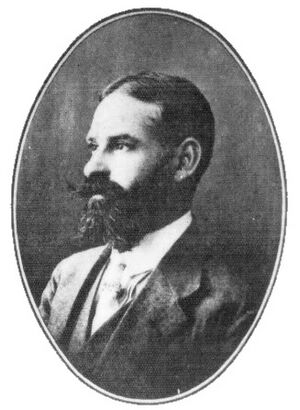Filip Mișea facts for kids
Quick facts for kids
Filip Mișea
|
|
|---|---|

Mișea in or around 1908
|
|
| Born | 1873 Chroupista, Ottoman Empire (now Argos Orestiko, Greece)
|
| Died | 16 May 1944 (aged 70–71) |
| Nationality | Ottoman, Romanian |
| Alma mater | Romanian High School of Bitola Carol Davila University of Medicine and Pharmacy |
| Occupation | Activist, physician and politician |
| Spouse(s) | Virginia Mustață |
Filip Mișea (1873 – 16 May 1944) was an important Aromanian activist, doctor, and politician. He made history by becoming a representative in the Ottoman parliament. He and Nicolae Constantin Batzaria were the only Aromanians ever to serve there. Later, Mișea moved to Romania and focused on his medical career.
Contents
Filip Mișea's Life Story
Early Life and Education
Filip Mișea was born in 1873 in a place called Chroupista. This area was part of the Ottoman Empire back then. Today, it is known as Argos Orestiko in Greece. His father was a teacher, and his mother was a homemaker.
After finishing high school in Bitola, Mișea moved to Romania in 1893. He studied medicine at the Carol Davila University. He graduated as a doctor in 1899. To pay for his studies, Mișea had to work hard.
While studying, Mișea also wrote articles for Aromanian newspapers. He wrote about the history of villages and local legends. One important article explained why a village called Gramos became empty. Another article shared the history of his own village.
After becoming a doctor, Mișea worked in different hospitals. His professor, a famous surgeon named Thoma Ionescu, encouraged him. He told Mișea to go back to the Ottoman Empire. His professor believed Mișea had a "mission" to help his Aromanian community there. So, Mișea and his wife, Virginia, returned.
Becoming a Politician in the Ottoman Empire
Once back in the Ottoman Empire, Mișea joined a political group called the Young Turks. This group wanted to make changes in the empire. Mișea became a "deputy," which is like a representative. He represented the area of Görice (now Korçë) in the Ottoman parliament. He served in 1908 and again in 1912.
Filip Mișea was one of only two Aromanians to ever be in the Ottoman parliament. The other was Nicolae Constantin Batzaria, who was a senator. The Young Turks mainly recruited members from Muslim groups. However, they also invited Aromanians and Jewish people to join them.
Mișea and Batzaria wanted to work with the Ottoman government. They hoped this alliance would protect the Aromanian people. Other groups in the empire had their own nationalist movements. These movements sometimes threatened the Aromanian community. The Young Turks also benefited from this. Having Christian allies like the Aromanians showed other Christian groups, like Bulgarians and Greeks, that they could work together.
Mișea was a key part of this alliance. He helped with talks between the Young Turks and the Macedo-Romanian Cultural Society. He was in charge of spreading information for the latter group.
Life and Work in Romania
In December 1913, Mișea decided to return to Romania. His wife and a Romanian politician, Take Ionescu, encouraged him. Mișea also felt he had completed his mission for the Aromanian cause. He wanted to raise his three young children in Romania.
Mișea decided to leave politics behind. He settled in a city called Buzău. Before that, he worked in several hospitals in smaller towns. During World War I, Mișea served as a doctor in a hospital in Bacău. He was later moved to a military hospital. There, he treated many soldiers who were hurt in the war. He even got sick with a serious illness called epidemic typhus, but he recovered quickly.
In the early 1920s, Mișea became a leader at the new Hospital of Infectious and Contagious Diseases in Buzău. He worked there until he retired in 1938. A linguist named Matilda Caragiu Marioțeanu wrote about Mișea in her book. She said Mișea helped a famous actor, Toma Caragiu, when he was a baby. Mișea helped him get over a stomach illness. She also mentioned that Mișea was called "Fil'io" by the Caragiu family and was her mother's godfather.
In 1929, Mișea's wife, Virginia, passed away. He remained a widower and never remarried. They had six children together. Some of their children also became doctors. Filip Mișea died on May 16, 1944.
Images for kids


